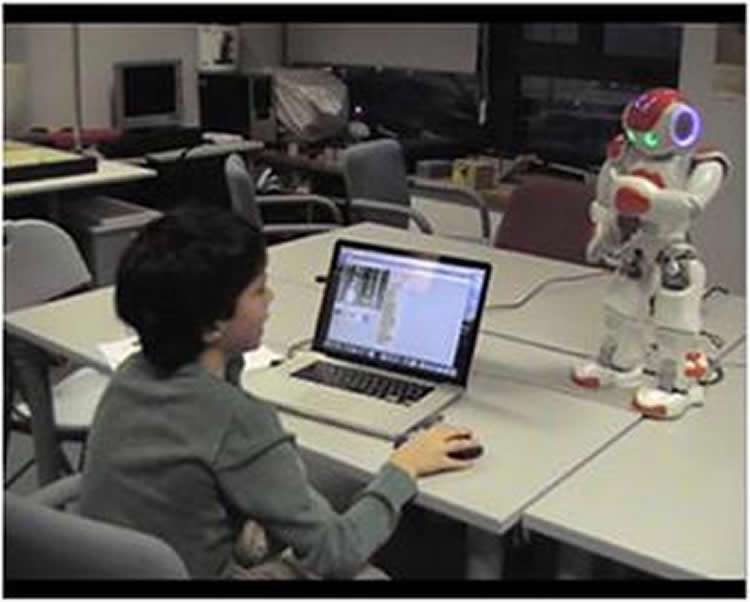Summary: A robotic system that can detect the emotional state of young learners and improve the learning experience is one step closer to entering the classroom, researchers report.
Source: Frontiers.
A step forward in using robotic tutors in primary school classrooms.
The use of robotic tutors in primary school classrooms is one step closer according to research recently published in the open access journal Frontiers in Computational Neuroscience.
Dr Imbernòn Cuadrado and his co-workers at the Department of Artificial Intelligence in Madrid have developed an integrated computational architecture (ARTIE) for use with software applications in schools.
“The main goal of our work was to design a system that can detect the emotional state of primary school children interacting with educational software and make pedagogic interventions with a robot tutor that can ultimately improve the learning experience,” says Luis Imbernòn Cuadrado.
Online educational resources are becoming increasingly common in the classroom, although they have not taken into sufficient account that the learning ability of primary school children is particularly sensitive to their emotional state. This is perhaps where robot tutors can step in to assist teachers.
Rather than focusing on specific emotions, the researchers first identified three cognitive states (concentrating, distracted and inactive) known to influence the course of learning. Keyboard strokes and mouse actions of children using educational software were used to predict which of these cognitive states the child is experiencing and subsequently linked to an algorithm that chooses the correct form of pedagogic intervention. These could be words and gestures of encouragement or attempts to raise interest and motivation for a specific learning objective, all of which can be delivered by a robot tutor.
In the Frontiers research article, Dr. Imbernón Cuadrado and co-workers describe an example of a robotic tutor platform, MONICA, which integrates the educational software Scratch to a commercially available robot through the computational architecture developed in their paper.

MONICA was tested out on two primary school volunteers known to have different cognitive learning states. Whilst the children enjoyed having a robot guide their learning, and preferred it to working alone, they both felt they would have learned more with their normal teacher, despite feeling more relaxed in the presence of a robot tutor.
“Our first prototype was designed to demonstrate that the architecture works in detecting simplified emotional states,” says Dr. Imbernón Cuadrado. “The next step will be to implement methods for detecting a more complex range of emotions with cameras and microphones and to test the longer term impact of robot tutors on children’s learning curves.”
It seems however that robot tutors are not ready to replace school teachers just yet. “We consider that robot tutors could have an effective support role to play in the primary school classroom in helping children reach their specific learning objectives,” concludes Dr. Imbernón Cuadrado.
Source: Michelle Ponto – Frontiers
Image Source: NeuroscienceNews.com image is credited to Luis-Eduardo Imbernon Cuadrado, SOPRA Steria, Madrid, Spain.
Original Research: Full open access research for “ARTIE: An Integrated Environment for the Development of Affective Robot Tutors” by Luis-Eduardo Imbernón Cuadrado, Ángeles Manjarrés Riesco and Félix De La Paz López in Frontiers in Computational Neuroscience. Published online August 3 2016 doi:10.3389/fncom.2016.00077
[cbtabs][cbtab title=”MLA”]Frontiers “A Step Closer to Robotic Tutors for the Classroom.” NeuroscienceNews. NeuroscienceNews, 24 October 2016.
<https://neurosciencenews.com/education-robotic-teachers-5333/>.[/cbtab][cbtab title=”APA”]Frontiers (2016, October 24). A Step Closer to Robotic Tutors for the Classroom. NeuroscienceNew. Retrieved October 24, 2016 from https://neurosciencenews.com/education-robotic-teachers-5333/[/cbtab][cbtab title=”Chicago”]Frontiers “A Step Closer to Robotic Tutors for the Classroom.” https://neurosciencenews.com/education-robotic-teachers-5333/ (accessed October 24, 2016).[/cbtab][/cbtabs]
Abstract
ARTIE: An Integrated Environment for the Development of Affective Robot Tutors
Over the last decade robotics has attracted a great deal of interest from teachers and researchers as a valuable educational tool from preschool to highschool levels. The implementation of social-support behaviors in robot tutors, in particular in the emotional dimension, can make a significant contribution to learning efficiency. With the aim of contributing to the rising field of affective robot tutors we have developed ARTIE (Affective Robot Tutor Integrated Environment). We offer an architectural pattern which integrates any given educational software for primary school children with a component whose function is to identify the emotional state of the students who are interacting with the software, and with the driver of a robot tutor which provides personalized emotional pedagogical support to the students. In order to support the development of affective robot tutors according to the proposed architecture, we also provide a methodology which incorporates a technique for eliciting pedagogical knowledge from teachers, and a generic development platform. This platform contains a component for identiying emotional states by analysing keyboard and mouse interaction data, and a generic affective pedagogical support component which specifies the affective educational interventions (including facial expressions, body language, tone of voice,…) in terms of BML (a Behavior Model Language for virtual agent specification) files which are translated into actions of a robot tutor. The platform and the methodology are both adapted to primary school students. Finally, we illustrate the use of this platform to build a prototype implementation of the architecture, in which the educational software is instantiated with Scratch and the robot tutor with NAO. We also report on a user experiment we carried out to orient the development of the platform and of the prototype. We conclude from our work that, in the case of primary school students, it is possible to identify, without using intrusive and expensive identification methods, the emotions which most affect the character of educational interventions. Our work also demonstrates the feasibility of a general-purpose architecture of decoupled components, in which a wide range of educational software and robot tutors can be integrated and then used according to different educational criteria.
“ARTIE: An Integrated Environment for the Development of Affective Robot Tutors” by Luis-Eduardo Imbernón Cuadrado, Ángeles Manjarrés Riesco and Félix De La Paz López in Frontiers in Computational Neuroscience. Published online August 3 2016 doi:10.3389/fncom.2016.00077






